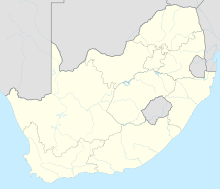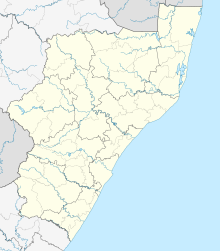
Back Slag van Isandlwana Afrikaans Batalla d'Isandhlwana AN معركة إيساندلوانا Arabic Битка при Исандлуана Bulgarian Batalla d'Isandhlwana Catalan Bitva u Isandlwany Czech Slaget ved Isandlwana Danish Schlacht bei Isandhlwana German Batalo apud Isandhlwana Esperanto Batalla de Isandlwana Spanish
| Battle of Isandlwana | |||||||
|---|---|---|---|---|---|---|---|
| Part of the Anglo-Zulu War | |||||||
 Lieutenants Melvill and Coghill flee the camp with the Queen's Colour of the 1st battalion of the 24th Regiment | |||||||
| |||||||
| Belligerents | |||||||
|
| Zulu Empire | ||||||
| Commanders and leaders | |||||||
|
Overall commander: |
Overall commander: | ||||||
| Strength | |||||||
|
No. 2 Column: |
Zulu Impi: | ||||||
| Casualties and losses | |||||||
|
Total: Over 1,300 killed:[4]
Material losses: 2 artillery pieces captured | Total: 3,000–5,000 | ||||||
Location of Isandlwana in present-day South Africa | |||||||
The Battle of Isandlwana (alternative spelling: Isandhlwana) on 22 January 1879 was the first major encounter in the Anglo-Zulu War between the British Empire and the Zulu Kingdom. Eleven days after the British invaded Zululand in Southern Africa, a Zulu force of some 20,000 warriors attacked a portion of the British main column consisting of approximately 1,800 British, colonial and native troops with approximately 350 civilians.[12] The Zulus were equipped mainly with the traditional assegai iron spears and cow-hide shields,[13] but also had a number of muskets and antiquated rifles.[14][15]
The British and colonial troops were armed with the modern[16] Martini–Henry breechloading rifle and two 7-pounder mountain guns deployed as field guns,[17][18] as well as a Hale rocket battery. The Zulus had a vast disadvantage in weapons technology,[19] but they greatly outnumbered the British and ultimately overwhelmed[20] them, killing over 1,300 troops, including all those out on the forward firing line. The Zulu army suffered anywhere from 1,000 to 3,000 killed.[21][22]
The battle was a decisive victory for the Zulus and caused the defeat of the first British invasion of Zululand.[23] The British Army had suffered its worst defeat against an indigenous foe equipped with vastly inferior military technology.[19] Isandlwana resulted in the British taking a much more aggressive approach in the Anglo–Zulu War, leading to a heavily reinforced second invasion,[24] and the destruction of King Cetshwayo's hopes of a negotiated peace.[25]
- ^ Knight, Ian. Zulu War 1879, Osprey Publishing, 2003, ISBN 1-84176-612-7, p. 33.
- ^ All figures from Holme, N. (1999) The Noble 24th: Biographical Records of the 24th Regiment in the Zulu War and the South African Campaigns, 1877–1879 pp. 377–78
- ^ Doyle, p. 120: "... around 20,000 ...". Colenso, p. 313, "The Zulu army, he (Nugwende) says, numbered 20,0000 ..." and p. 312, "... full nominal strength reaches a total of 30,900 men but the actual numbers are estimated at from 20,000 to 25,000
- ^ Knight (2002), p. 86
- ^ a b c Cite error: The named reference
NHoSA-166was invoked but never defined (see the help page). - ^ Smith-Dorrien, Chapter 1D, "... nearly 900 British and 2,000 or 3,000 natives, friend and foe, had breathed their last on the fatal 22nd."
- ^ Lock, p. 224
- ^ Colenso, p. 312, gives 1333 also states a "given" total as 822 but says the actual loss is slightly higher
- ^ Knight, Ian. Isandlwana 1879: The Great Zulu Victory, Osprey, 2002, p. 86, "Zulu casualties were almost as heavy (as the British). Although it is impossible to say with certainty, at least 1,000 were killed outright in the assault...". Knight's estimate of Zulu casualties is more in keeping with those suffered by the Zulu at Kambula, where a British column forms an excellent defensive position with a wagon lager, six 7 pounder artillery pieces and 2,000 soldiers and inflicts 800 (counted bodies) – 1,000 killed on the Zulu. Similarly, Knight & Castle. Zulu War 1879: twilight of a warrior nation, 1992, p. 54 and in their Zulu War, 2004, p. 114, state that the Zulu casualties at Kambula and Isandlwana are comparable. Again, Ian Knight. Brave Men's Blood, The Epic of the Zulu War, 1879, (1990), p. 142, "785 [bodies] were collected from close by the camp", while there is a British pursuit at Kambula that inflicts many casualties on the Zulu, there is only the British retreat at Isandlwana during which the Zulu inflict many casualties. Also Laband, Historical Dictionary, 2009, p. 123.
- ^ Smith-Dorrien, Chapter 1D, "The next few days after the battle, St. Matthew's simile, " Wheresoever the carcase is, there will the eagles be gathered together," was fully illustrated, for literally the sky was darkened at times by continuous streams of " Aasvogels " heading from all directions to the battlefield marked by that precipitous and conspicuous crag, like a lion couchant, " Isandhlwana " where nearly 900 British and 2,000 or 3,000 natives, friend and foe, had breathed their last on the fatal 22nd." As can be seen from this account there were from both sides a total of 2 to 3 thousand natives killed.
- ^ Victor David Davis Hanson, "Carnage and Culture: Landmark Battles in the Rise to Western Power", p. 282, Anchor Books, 2002. Hanson highlights Zulu accounts of how simply being hit by a Martini Henry .45 slug was usually enough for a crippling or maiming wound and in the absence of effective medical care, many wounded Zulus died, within several hours or a few days as result of wounds sustained at Isandlwana.
- ^ Knight (2002), p. 49, Knight gives a total of 1,768 combat troops, not including wagon drivers and other civilians, of which there were some 350, Colenso, p. 263
- ^ Christon I. Archer World History of Warfare, Univ of Nebraska Pr, 2008, ISBN 0-8032-1941-5, p. 462 "They had a national army of twenty-five thousand men equipped with cowhide shields, assegais and clubs."
- ^ Smith-Dorrien, Chapter 1B "It was a marvellous sight, line upon line of men in slightly extended order, one behind the other, firing as they came along, for a few of them had firearms, bearing all before them." eyewitness account, emphasis added
- ^ Ian Knight, Angus McBride Zulu 1816–1906, Osprey Publishing, 1995, ISBN 1-85532-474-1, p. 25
- ^ Lock, p. 40
- ^ Hall, Major D.D. (January 1979). "Artillery in the Zulu War – 1879". Military History Journal. 4 (4). The South African Military History Society.
- ^ "John McAdam, FRGS, "The Role of the Royal Artillery during the Anglo Zulu War"". Archived from the original on 13 March 2014. Retrieved 13 March 2014.
- ^ a b Doyle, p. 118: "It was here ... the British Army suffered its worst ever defeat at the hands of a technologically inferior indigenous force." (emphasis added)
- ^ Morris, pp. 366–67
- ^ "When Spears Beat Cannons: The Battle of Isandlwana". 29 December 2020.
- ^ Ian Knight Rorke's Drift 1879 Osprey Publishing, 1996, ISBN 1-85532-506-3.
- ^ Thompson, p. 75 "Thus ended the first British invasion of Zululand." Knight (2003), p. 27 Map titled: "First invasion of Zululand".
- ^ Morris, pp. 498–511, Chapter 'The Second Invasion'
- ^ Spiers, p. 42, "... reports of the annihilation ... prompted the Cabinet to send reinforcements and galvanized interest in the war." Ian Knight, Zulu War, Osprey, 2004, p. 11, "The home government, embarrassed by Isandlwana, sought to restore British honour by despatching more reinforcements ..."

